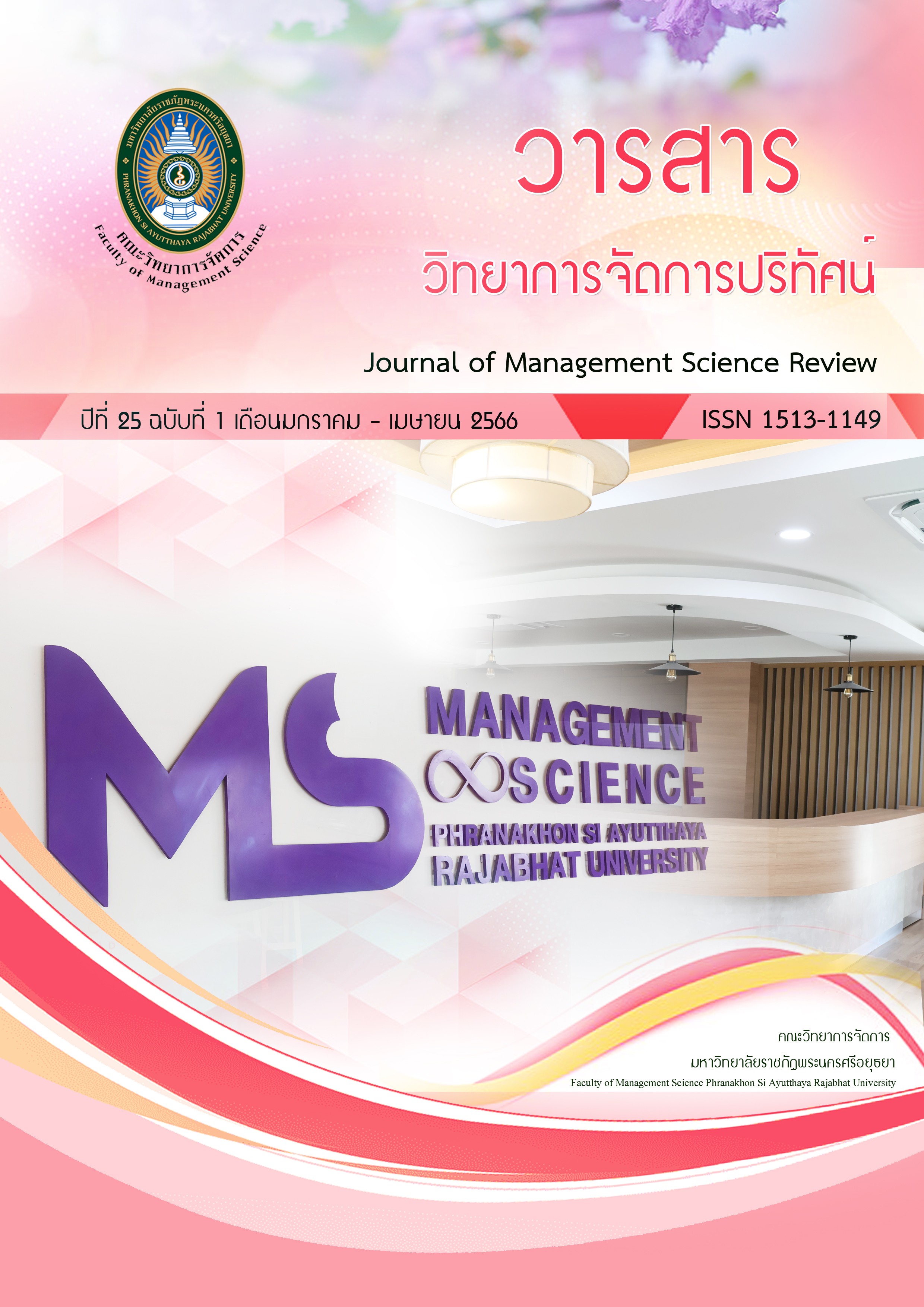A Cluster Analysis of Tourist based on Gastronomic Experiences on the Value Perceived in Phetchaburi Province
Keywords:
A Cluster Analysis of Tourist, Gastronomic Experiences, Gastronomy Tourism Activities, Cluster Analysis, Tourist BehaviorAbstract
The objectives of this study were to examine the behavior of gastronomy tourists in Phetchaburi Province and to categorize tourists based on the perceived value of their gastronomic experiences in Phetchaburi Province. The sample consisted of 402 individuals who had gastronomic experiences in Phetchaburi Province and perceived its value. Checklists were used in a questionnaire, and the data analysis statistics included frequency, percentage, mean, standard deviation, and K-Mean cluster analysis.
This study found: 1) Most gastronomy tourists joined activities as a way of life and culture of eating in markets, communities, and religious ceremonies with the purpose of traveling to support local products and made the decision to travel as a one-day trip by themselves. Gastronomic experiences in Phetchaburi Province were 4.23, 4.17, 4.16, 4.15, and 4.04 for city food brand image, consumer return on investment, playfulness, aesthetics, and service excellence, respectively. 2) A three-group of K-Mean clustering analysis was performed. First, 90 people (22.39%), mostly between the ages of 31-50 years old, had poor gastronomic experiences. Second, high gastronomic experiences on the value perceived comprised 108 people (26.87%), mostly between the ages of 21-30 years old, and third, medium gastronomic experiences on the value perceived comprised 204 people (50.74%), mostly between the ages of 31-50 years old.
References
การท่องเที่ยวแห่งประเทศไทย. (2560). Food Festival. จุลสารวิชาการการท่องเที่ยว การท่องเที่ยวแห่งประเทศไทย, 3(1), 13-16.
กัลยา วานิชย์บัญชา. (2556). การวิเคราะห์สถิติ: สถิติสำหรับการบริหารและวิจัย. (พิมพ์ครั้งที่ 14). กรุงเทพฯ: จุฬาลงกรณ์มหาวิทยาลัย.
จีระศักดิ์ คำสุรีย์, เมธาวี ชุณหวุฒิยานนท์ และดุจเดือน บุญสม. (2563). รายงานฉบับสมบูรณ์ (Final Report) กลยุทธ์การพัฒนาอาหารเพื่อสุขภาพและโภชนาการสมวัย ภายใต้แผนงานโครงการพัฒนาศูนย์อัจฉริยะอุตสาหกรรมอาหาร ปีงบประมาณ พ.ศ. 2563. กรุงเทพฯ: อุตสาหกรรมพัฒนามูลนิธิเพื่อสถาบันอาหาร.
ณนนท์ แดงสังวาลย์ และประสพชัย พสุนนท์. (2563). การท่องเที่ยวเชิงอาหารในสังคมต่างวัฒนธรรม: ประเทศไทยและมาเลเซีย. วารสารรัตนปัญญา, 5(2), 64-80.
บุณยสฤษฎ์ อเนกสุข. (2560). การท่องเที่ยวแบบเนิบช้า (Slow Travel): นิยามและแนวคิด. วารสารมนุษยศาสตร์และสังคมศาสตร์, 8(1), 26-47.
ภาณุวัฒน์ ภักดีอักษร. (2555). ทฤษฎีแรงจูงใจการท่องเที่ยวกับการท่องเที่ยวเชิงอาหาร. วารสารวิทยาการจัดการ, 29(2), 129-148.
ภาณุวัฒน์ ภักดีอักษร และปทุมมาลัย พัฒโร. (2564). การวิเคราะห์ปัจจัยองค์ประกอบเชิงสำรวจของแรงจูงใจนักท่องเที่ยวต่างชาติเพื่อการท่องเที่ยวเชิงอาหารในจังหวัดภูเก็ต ประเทศไทย. วารสารมนุษยศาสตร์วิชาการ, 28(2), 1-27.
สริตา พันธ์เทียน, ทรงคุณ จันทจร และมาริสา โกเศยะโยธิน. (2560). รูปแบบการจัดการท่องเที่ยวเชิงอาหารไทยโดยใช้แนวคิดเศรษฐกิจสร้างสรรค์ในเขตจังหวัดลุ่มแม่น้ำภาคกลาง. Research and Development Journal Suan Sunandha Rajabhat University, 9(3), 190-198.
สํานักงานจังหวัดเพชรบุรี กลุ่มงานยุทธศาสตร์และข้อมูลเพื่อการพัฒนาจังหวัด. (2561). แผนพัฒนาจังหวัดเพชรบุรี พ.ศ. 2561-2565 (ฉบับทบทวน). ค้นเมื่อ 20 สิงหาคม 2564, จากhttps://dl.parliament.go.th/handle/20.500.13072/589888
สํานักงานประชาสัมพันธ์จังหวัดเพชรบุรี. (2564). จังหวัดเพชรบุรีเร่งหาแนวทางการขับเคลื่อนเมืองเพชรบุรี. ค้นเมื่อ 20 สิงหาคม 2564, จากhttps://thainews.prd.go.th/th/news/detail/TCATG211011162020619
สำนักงานสถิติแห่งชาติ. 2560. รายงานฉบับสมบูรณ์ เรื่องการสำรวจพฤติกรรมการเดินทางท่องเที่ยวของชาวไทย พ.ศ. 2560 (ในรอบปี 2559). ค้นเมื่อ 1 เมษายน 2563, จาก http://www.nso.go.th
อัญชลี สมใจ พันธุ์รวี ณ ลำพูน (2563). พฤติกรรมและความต้องการของนักท่องเที่ยวที่มีต่อการท่องเที่ยวเชิงวัฒนธรรม ตำบลบางโฉลง อำเภอบางพลี จังหวัด สมุทรปราการ. Liberal Arts Review, 15(2), 13-27.
Boniface, P. (2016). Tasting Tourism: Travelling for Food and Drink. New York: Routledge.
Buiatti, S. (2011). Food and tourism: the role of the “Slow Food” association. Food, Agri-Culture and Tourism. Berlin: Springer.
Bukharov, I., & Berezka, S. (2018). The role of tourist gastronomy experiences in regional tourism in Russia. Worldwide Hospitality and Tourism Themes, 10(4), 499-457.
Future market insights. (2022). 2017-2021 Food Tourism Market Outlook Compared to 2022-2032 Forecast (2022-2032). Retrieved November 4, 2022, from https://www.futuremarketinsights.com/reports/food-tourism-sector-overview-and-forecast
Hall, C. M., & Sharples, L. (2003). The consumption of experiences or the experience of consumption? An introduction to the tourism of taste. In Food tourism around the world (pp.1-24). Routledge.
Holmlund, M., & others. (2020). Customer experience management in the age of big data analytics: A strategic framework. Journal of Business Research, 116, 356-365.
Park, E., Kim, S., & Yeoman, I. (2019). Eating in Asia: Understanding food tourism and its perspectives in Asia. Food tourism in Asia, 3-13.
Thailand Convention and Exhibition Bureau. The Future of Food Tourism in Thailand. Retrieved August 25, 2021, from https://skift.com/2019/11/15/the-future-of-food-tourism-in-thailand/
Tsai, C. T. S., & Wang, Y. C. (2017). Experiential value in branding food tourism. Journal of Destination Marketing & Management, 6(1), 56-65.
Urry, J. (2002). The Tourism Gaze. (2rd ed.). London: Sage.




